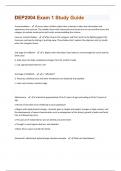DEP2004 Exam 1 Study Guide
Accommodation - occurs when children adjust their schemes to take new information and
experiences into account. The toddler learns that motorcycles and trucks are not cars and fine-tunes the
category to exclude motorcycles and trucks, accommodating the scheme
Insecure resistant babies - often cling to the caregiver and then resist her by fighting against the
closeness, perhaps by kicking or pushing away. These babies don't explore the playroom and cry loudly
when the caregiver leaves.
2nd stage of childbirth - a. Begins when the baby's head starts to move though the cervix and the
birth canal
b. Ends when the baby completely emerges from the mother's body
c. Last approximately 45min to 1hr
3rd stage of childbirth - a. "Afterbirth"
b. Placenta, umbilical cord, and other membranes are detached and expelled
c. Lasts only minutes, shortest stage
.
Adolescence - o Entered at approximately 10 to 12 years of age and ending at 18 to 21 years of
age
o Period of transition from childhood to early adulthood
o Begins with rapid physical change - dramatic gains in height and weight, changes in body contour, and
the development of sexual characteristics such as enlargement of the breast, growth of pubic and facial
hair, and deepening voice.
o The pursuit of independence and an identity are preeminent
o Thought is more logical, abstract, and idealistic
o More time is spent outside the family
Ainsworth's attachment styles/strange situation example - What are listed below?
,securely attached babies
insecure avoidant babies
insecure resistant babies
insecure disorganized babies
Anger cry - variation of the basic cry in which more excess air is forced through the vocal cords.
Apgar scale- 5 measurements - used to assess the health of newborns at one to five minutes after
birth. This scale evaluates an infant's heart rate, respiratory effort, muscle tone, body color, and reflex
irritability. The Apgar scale is especially good for assessing the newborn's ability to cope with the stress
of delivery and the demands of a new environment.
Assimilation - occurs when children use their existing schemes to deal with new information and
experiences. A toddler who has learned the word car to identify the family vehicle might call all vehicles
cars. The toddler has assimilated these objects to his existing scheme.
Autonomy v shame and doubt - o Occurs in late infancy and toddlerhood
o If infants and toddlers are restrained too much or punished too harshly, they are likely to develop a
sense of _____ or _____
Axon - carries signals away from the cell
Babbling - occurs in the middle of the first year. They produce stings of consonant-vowel
combinations, such as "ba, ba, ba, ba, ba."
Babies show a preference for drawings of - faces
Basic cry - a rhythmic pattern that usually consists of a cry, followed by a briefer silence, then a
shorter whistle that is somewhat higher in pitch than the main cry, then another brief rest before the
next cry. Some infancy experts believe that hunger is one of the conditions that incite the this cry.
, Behavioral theory - the idea that all behaviors are acquired through conditioning- occurs through
interactions with the environment. Behaviorists believe that our responses to environmental stimuli
shape our actions. B.F. Skinner is a behaviorist.
Brain lateralization - specialization of function in one hemisphere of the cerebral cortex or the
other. To some extent, the type of information handled by neurons depends on whether they are in the
left or right hemisphere of the cortex. Speech and grammar, for example, depend on activity in the left
hemisphere in most people; humor and the use of metaphors depends on activity in the right
hemisphere.
Breech position - when the baby's buttocks are the first part to emerge from the vagina. 1 in every
25 deliveries results in a breech position which causes respiratory problems for the baby; cesarean
section is required to deliver these babies.
Bronfenbrenner's ecological theory/approach - development reflects the influence of several
environments. The theory identifies five environmental systems: microsystem, mesosystem, exosystem,
macrosystem, and chronosystem.
cephalocaudal patterns - the sequence in which the earliest growth always occurs at the top- the
head- with physical growth and differentiation of features gradually working their working their way
down from top to bottom (For example, shoulders, middle trunk, and so on). Motor development
generally proceeds according to the cephalocaudal principle. For example, infants see objects before
they can control their torso, and they can use their hands long before they can crawl or walk.
Chomsky's - language acquisition device - Chomsky proposed that humans are biologically
prewired to learn language at a certain time and in a certain way. He said that children are born into the
world with a language acquisition device (LAD), a biological endowment that enables the child to detect
certain features and rules of language, including phonology, syntax, and semantics. Children are
equipped by nature with the ability to detect the sounds of language, for example, and to follow rules
such as how to form plurals and ask questions. Chomsky's LAD is a theoretical construct, not a physical
part of the brain.
Chronosysyem - o Patterning of environmental events and transitions over the life course, as well
as sociohistorical circumstances.
o Example: divorce is a transition.




